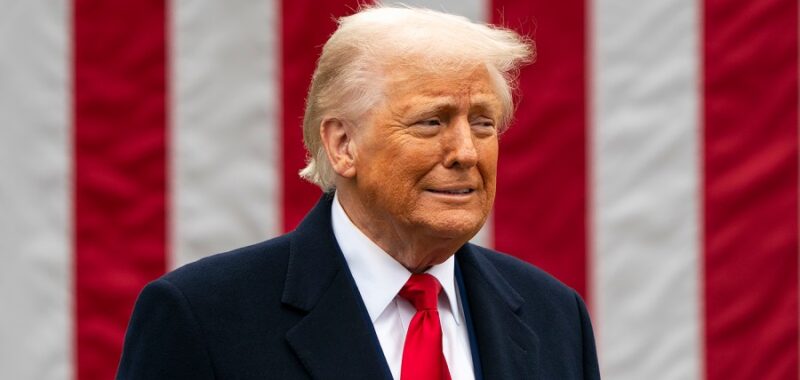
At home and around the world, Donald Trump’s so-called “Liberation Day” tariffs are sending shockwaves across global markets and diplomatic circles. Targeting aluminum, steel, cars and even fentanyl imports, these tariffs are set to spark significant legal challenges and diplomatic backlash.
The looming question is whether Liberation Day was a masterstroke of economic nationalism or a reckless gamble that could upend international trade laws and the broader economy.
The smart money is on Door No.2.
For Trump, tariffs have always been a go-to weapon. He used them liberally during his first term, imposing duties on China and other trade partners under the banner of protecting American jobs and manufacturing. But this latest round goes even further, branding the new tariffs as a way to break free from what he calls economic dependence on foreign powers. The political messaging is clear: America First, everyone else second. But the legal landscape is far murkier, and the potential consequences are vast.
What actually happened on Wednesday in the Rose Garden was massively anticlimactic — a rambling speech with inexact and fictitious numbers that was far more like a political rally than anything else. This leaves us with the immediate question as to what, exactly, the tariffs will be with each nation. Aside from the 25 percent automobile tax Trump mentioned, we will have to separate fact from fiction as to what actually constitutes a reciprocal tariff.
Another one of the biggest questions surrounding these tariffs is whether they are even legal under international trade agreements. The World Trade Organization (WTO) has repeatedly ruled against Trump-era tariffs in the past, finding that they violated global trade norms. If the past is prologue, expect a flood of legal challenges from affected countries, and don’t be surprised if the WTO steps in once again.
The problem, of course, is that Trump has shown little regard for WTO rulings, and his administration could simply continue to ignore them. This sets a dangerous precedent — trade agreements become meaningless if the world’s largest economy refuses to play by the rules.
Then there’s the diplomatic fallout. These tariffs aren’t just an economic issue; they’re a massive foreign policy grenade.
Countries like Canada, Germany and China immediately began to signal their outrage, warning of retaliatory measures that could escalate tensions further. The European Union, which has already had its fair share of trade disputes with the U.S., may slap its own tariffs on American exports in response. And China? If Trump is hoping this move will deter Chinese exports of fentanyl-related products, he might be in for a rude awakening. China could just as easily retaliate by cutting off rare earth minerals or making life difficult for American companies operating there.
In short, this could turn into a full-scale trade war with no clear winner.
For U.S. businesses and consumers, the impact of these tariffs will be felt quickly, no matter what spin the White House chooses to put on it over the next hours and days.
Higher costs on imported steel and aluminum mean price hikes for everything from cars to appliances. Auto manufacturers, already dealing with supply chain disruptions and rising costs, are bracing for a financial hit. Construction companies relying on metal imports will see their expenses rise, which could push up housing and infrastructure costs. And let’s not forget consumers, who will likely pay more for everyday goods as companies pass on the increased costs.
This is the classic problem with tariffs — they’re often billed as punishments for foreign countries, but in reality, they hit American businesses and consumers just as hard, if not harder.
Beyond the economic and diplomatic concerns, there’s also the political dimension. By rolling out these Liberation Day tariffs, Trump is reinforcing his America First brand just as the 2026 election season heats up. But will this strategy pay off? Some economists argue that tariffs ultimately cost American jobs rather than save them, as retaliatory measures from other countries hurt U.S. exports. If economic pain starts hitting voters’ wallets, the political calculus could shift, especially among independent voters and business-minded conservatives who have long been skeptical of Trump’s trade policies.
Looming over all of this is the reality that markets don’t like uncertainty, and broad, aggressive tariffs introduce a massive dose of it. Investors are watching closely to see how trade partners react and whether this move signals a larger shift toward protectionism. If these tariffs trigger countermeasures and a broader trade war, the economic consequences could be severe. Supply chains, already fragile from years of disruptions, could be thrown into further chaos. Inflation, which has been a major concern in recent years, could be exacerbated if companies pass on higher costs to consumers. The stock market, which tends to react negatively to trade uncertainty, could see volatility spike.
In the end, the Liberation Day tariffs represent a high-risk, high-reward strategy for Trump. If they lead to concessions from trade partners and a revival of U.S. manufacturing, he will claim victory and use it as proof that his economic policies work. But if they spark retaliatory tariffs, legal battles and economic instability, they could go down as another example of Trump’s aggressive, but ultimately flawed, approach to trade.
What’s certain is that the world is watching closely, and the next moves from key global players will determine whether this is the beginning of a new era of economic nationalism or the start of what history will see as a ridiculous and completely unnecessary trade war spiral.
Aron Solomon is the chief strategy officer for Amplify. He has taught entrepreneurship at McGill University and the University of Pennsylvania.

